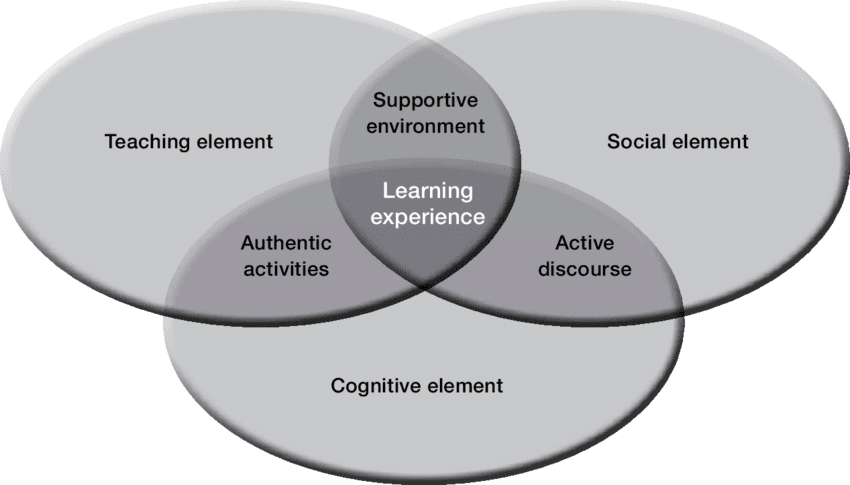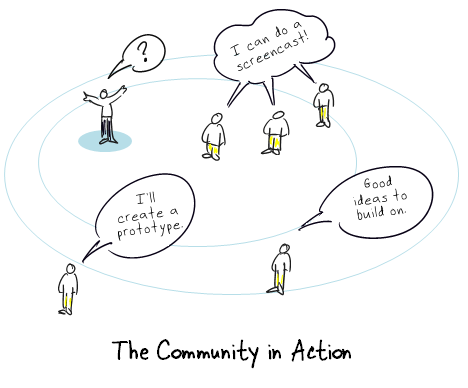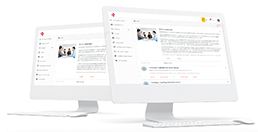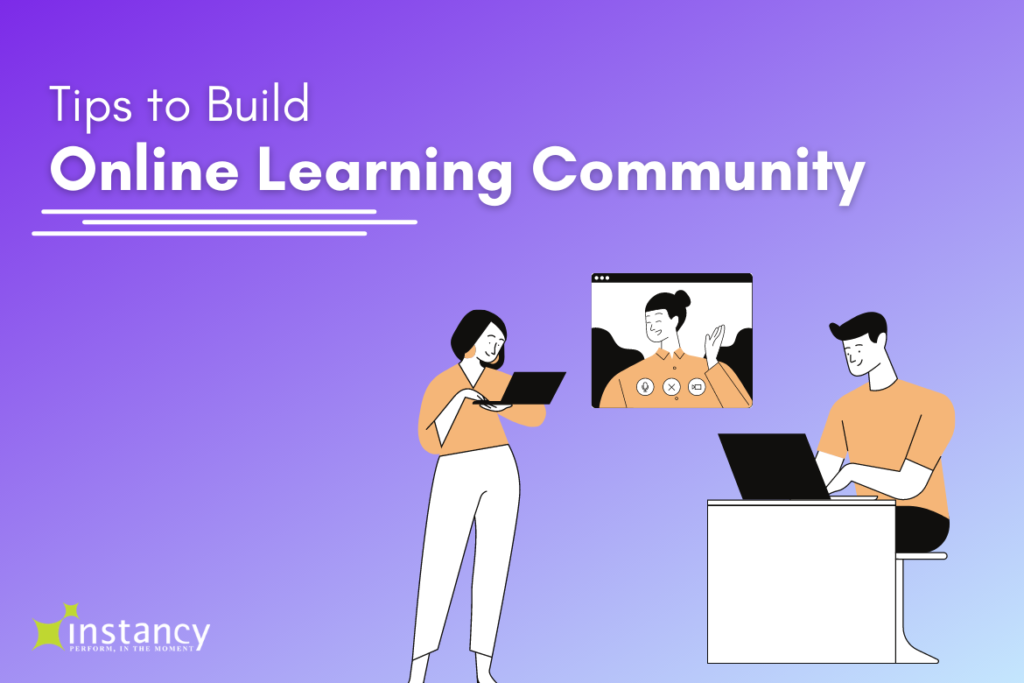Covid-19 has turned our lives upside down, and so the academics. Moving into online classrooms happens to be the new normal. Feeling cared for and connected with others became one of the major concerns.
Expected isn’t it?
Learning in an unconnected atmosphere can cause performance and enthusiasm to plummet. The only thing one can do is to promote learning by encouraging learners to become a part of a learning community (which is a challenge in itself!).
The idea behind this is to provide more than just a piece of absorbing information. It means providing an online learning experience that is more authentic, more human, and conclusively, more achievable.
Here, an online facilitator has a crucial role to play, especially when talking about building this sense of belonging in a learning community.
In this write-up, we will show you what it takes to build an online learning community. But first, let us start with the basics;
Online Learning Community: The Essence
An online learning community is a group of learners having a similar set of learning goals. These communities serve as a platform where people can connect to share information, discuss courses or topics, and more.
The learners with common educational goals collaborate to connect with the instructors and engage in peer-to-peer learning. Online learning communities complement online courses because they allow social learning, student-to-teacher support, and much more.
They also help to establish accountability, as students work in cohorts to support each other towards the learning goals.
Now talking about the trainers and professors, they organize and provide training as per the instructions or process. For them, the online learning community is a means to conduct training in a well-managed social setting in a casual manner.
Quite interesting isn’t it?
Now that you know all about what an online learning community is, let us now move forward to understand it in a better way.
Identifying the Types of Online Learning Communities
Online learning communities can be categorized into the following types. These types are differentiated based on the purpose that brings them together:
- Interest & Passions-Based Community: This type of online learning community is for individuals with mutual interests or passions.
- Action-Based Community: This type is for the ones who wish to come together for a cause. For Instance, raising funds to conduct a seminar or even a webinar.
- Location-Based Communities: These types of communities are based within geographic boundaries. For instance, a local Facebook group that highlights the best eateries around your town.
- Profession- Based Communities: People of a particular profession come here together to share their views, knowledge, and more to help each other. For example, nurses create a group to gain more professional knowledge or painter groups to master their skills or craft.
Getting to the Depths of Learning Community
Now, it’s time to dig a little into the depths of the learning community!

To build an online learning community, you first need to categorize it depending on the following constructive elements, and they are:
1. Teaching Presence:
It involves the elements that we might generally think of when considering to teach, such as:
a. Design & Planning: Working on the expected behavior, forming, and enforcing new organizational skills are crucial to teaching presence.
b. Direct guidance: This includes scaffolding, supporting, and providing assistance for the students who need help from the professor or other learners.
c. Facilitating discussions: This function is known to contribute to providing a sense of community and education.
Related Read: What Is Instructional Design?
2. Social Presence
Here, participants can identify the group and communicate in a trusting atmosphere. It is to build social relationships by expressing their personality. There are two elements of social presence, they are:
a. Interactivity: It provides you with a sense of participation and reciprocity that makes you feel like a part of something. Interactivity can also happen directly in the classroom.
However, to build an online learning community, you should use the following combinations:
Professor- Learner
Learner- Learner
Content- Learner
b. Trust: Here, you build trust using your positive experiences and knowledge to know others in the community. Remember, privacy and trust hold a symbiotic bond here. Privacy provides credibility that builds trust. Trust eases out the concerns related to our privacy.
3. Cognitive Presence
This includes exploration, development, confirmation to promote a sense of understanding. Cognitive presence is generally carried out in the following four phases:
a. Triggering Events: It can be a query presented to the community, or identification of a problem.
b. Exploration: It involves creating a space where group members can express, share opinions, make suggestions, and do a lot more.
c. Synthesis: This section promotes convergent thinking. Here, the synthesis of ideas occurs, and you work towards identifying the solution.
d. Resolution: This means that you have a solution to the problem. Also, the community helps to resolve the issue or event that recently took place.
Whats and Whys of Moving Online
Online communities can be a great source to bring your students on a single platform together. Learners can discuss the course content, ask questions, and implement new techniques to their learnings in a better way. Also, you get a pulse check of your audience and things they wish to learn from you.

Apart from these, there are several reasons to build an online learning community:
- You can present yourself as a leader of your space: Being the leader, you can expand your circle and grow your network.
- Build a brand: You can increase your referrals by using brand evangelists. You can also ask your students to take individual responsibility and contribute to the authenticity of your community.
- User Review: Having a one-on-one discussion with your students helps you to improve your services and support.
- Grow revenue: A community can foster more followers, increase the rate of retention, and you can increase your sales.
- Coping up with the market shifts: Online Learning community can help you maintain touchpoints with your students when being physically present is not possible.
Benefits of Building Online Learning Community
There are several benefits for entrepreneurs that are planning to build an online community;
- Gaining Clients
- Add value for learners
- Get regular feedback to enhance your course
- Market the course better with insight into their requirements as well as the pain points.
- You have a platform to promote your endeavors by using Podcasts, webinars, and more.
- It keeps your students closer.
To avail of these benefits, you need to understand the challenges you may face during your journey. For example, you need a platform that can attract the learners and want to engage them for long (which is not just limited to selling them a course).
“Energy and persistence conquer all things.”
Benjamin Franklin
So, keep up with the hard work to overcome the challenges and you will shine like a winner in no time.- All you need is being persistent!!
It’s not time to move onto the tips and tricks to build an online learning community with a bang!
How to Build An Online Learning Community?
Learning management systems can provide you with an ideal solution for entrepreneurs. It is easy to use and can host your courses well with the tools you require to build an online learning community.
Enough of the benefit. Here’s how you can build an online learning community:
1. Create a Platform to Establish Presence
A welcome page to represent your community does a lot more than you can imagine. It also provides the learners with the idea of what the community is all about. Therefore, a welcome page serves as your community’s face (it’s up to you to greet your learners with a smiling face or with a poker face!).
You must use this area in such a way that it picks the tone and sets the expectations for the course. It also assures them that you will be ready to guide them throughout their journey.
Also, always remember that your community is a place where the learners can actively participate in discussions. Keeping that in mind, try highlighting your options, emails, chats, and more. Add FAQs to answer the basic questions and build a space where the learners can interact without hesitation.
2. Categorize Groups Around Similar Interests
A community is a gathering place for learners having common interests. For instance, if your community centers around digital marketing, there can be a different group for Content Marketing, Social media Marketing, and Search Engine Optimization.
It is a good idea to create separate groups for every course. Make sure that these groups are based on the preferences of your learners. Also, having different groups is great for sharing your resources to promote learning among the participants.
3. Work on Social Networking and Display Online Users
Being a little skeptical about this section is normal! Once you get connected to the learners, you will feel confident. Talk to them, ask you to share their book of suggestions or recommendations for your community. It is a great option as it will act like an ice-breaking session that will benefit both you and the learner in the long run.
Who wants to wait for an instructor to initiate an interaction every day? Shhh…Here’s a secret… No-one likes it!
Let the learners add their friends, as well as see when their friends were online. This provides you with a win-win-situation as learners will surely appreciate the networking as a core feature of your learning platform.
4. Utilize Activity Feeds
The activity feeds tend to have several purposes, and they are:
- General announcements
- Event Updates
- Reminders
- Upcoming Courses
- Offers
- and more
The learners can easily keep themselves updated with everything that is going around. They also get timely notifications, and thus, they do not miss anything important. They can keep an eye on everything, which is in action or going to happen.
5. Make The Most of the Chatting Features
As mentioned earlier, a friendly approach to establish communication always gives you the best outputs. It is great as people are quite busy and do not have much time to read about the courses.
Here, private messaging allows the professors to communicate with the learners to share their knowledge and answer the questions according to their convenience. Having a chat tool is recommended because it lets you respond quickly whenever required.
Learners can also use them to communicate with each other, using external tools like private emails and more.
6. Add in Some Blogs
Having a blog section for your community is not a compulsion. However, if you have the time, then write to interact with your learners. Let us help you explain this in a better way, consider writing a blog post about your recent interest in business, cooking, singing, etc. You can also ask your learners to write feature guest posts. You can also preview things you have been working on presently.
7. Create or Enable Forums
Even if the information is at its own pace, it does not mean that your learners have to limit themselves from sharing their knowledge or viewpoints. Forums are said to be the most popular ways of establishing communication for online communities.
You can break the ice right from the start by asking your audience to introduce themselves. From there onwards, you can create discussions for various topics (just to make your learners comfortable). Forums here will help you to do so.
8. Encourage Students to Use the App
It is possible that most of your learners would check their courses while on the go or even waiting for their food at a restaurant. Here, LMS has a huge advantage as it comes with a mobile app, that lets the users download for free.
The learners can access their courses by using the app at any point in time and from anywhere. Additionally, they also get several notifications from time to time, which will help them to keep up with everyone else. Therefore, encouraging them to use the app can provide you with fruitful results.
Related Read: What Makes a Great Mobile Learning App?
9. Learning Management Systems: Gamification
The right learning management system allows you to create great content in terms of learning. LMS solutions also come with various features such as gamification. This feature lets the learners earn points and badges on completing an assignment.
You can also display the achievements of your learners by creating a scoreboard to keep them motivated. After all, an online learning community that shares together stays together as one!
Last But Not Least [Bonus Tip]
Building an online learning community can be a little more daunting than it seems. However, the right LMS has all the tools you require to communicate with your learners effectively. You don’t need to use them all at once. Always start with the baby steps.
For example, starting up with a forum related to courses might be enough, and gradually you can move ahead to the groups, chats, and more. It comes with an immense value in terms of learning from each other.
People search for the ones with similar interests, and the online platforms provide them with the best ways possible. It also encourages them to learn new skills and establish long-term relationships.
So, why not build an online learning community that your learners are looking for?





